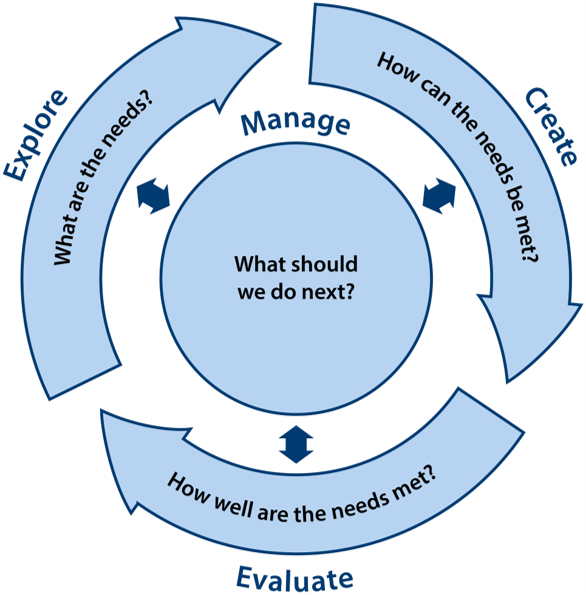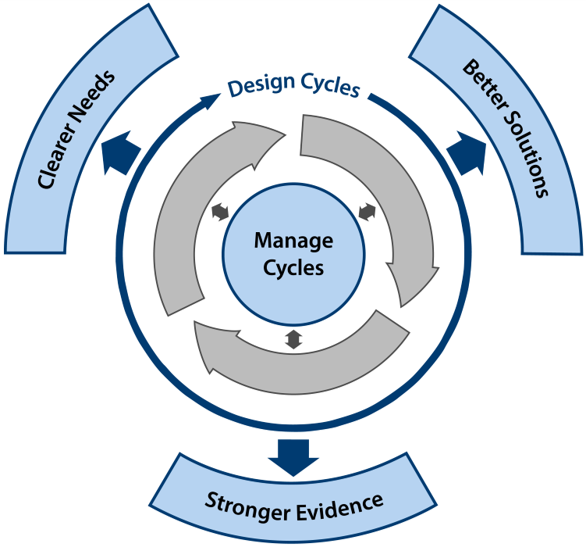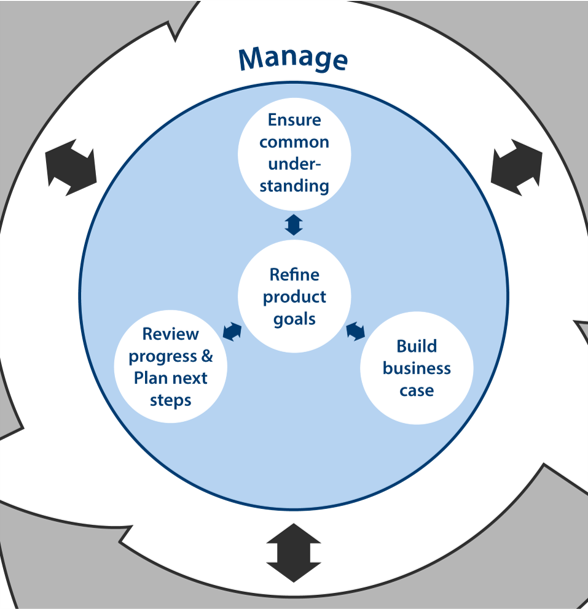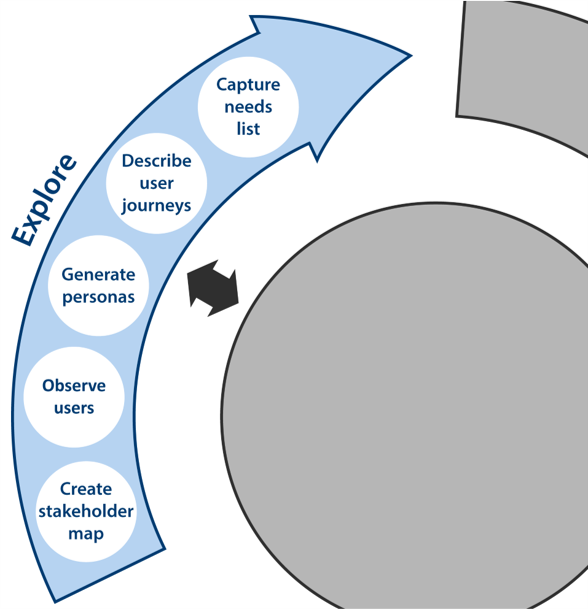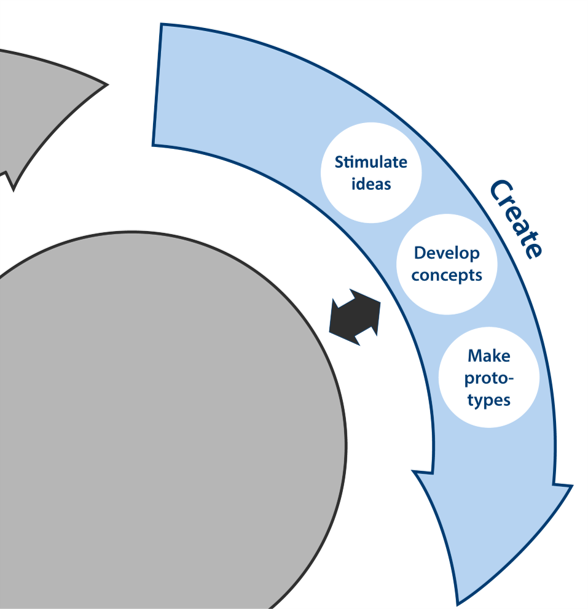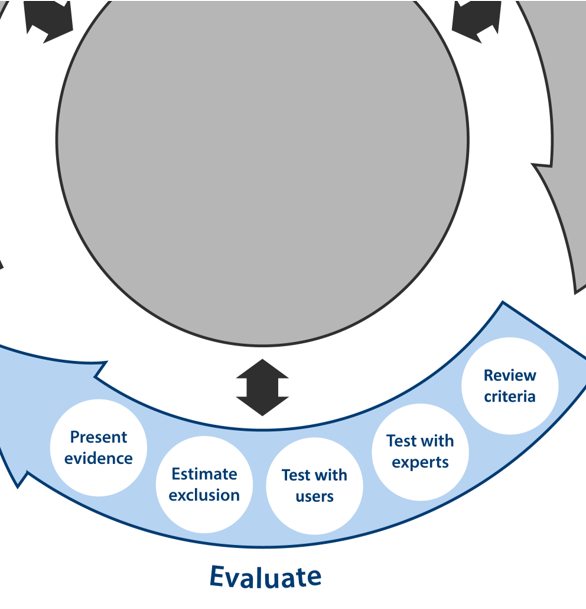Every design decision can make the user experience better or worse. Successful inclusive design requires informed decision-making at the concept stage, because it can become prohibitively expensive to make changes later on.
This page describes the four main phases of inclusive concept design:
- Manage: Review the evidence to decide ‘What should we do next?’
- Explore: Determine ‘What are the needs?’
- Create: Generate ideas to address ‘How can the needs be met?’
- Evaluate: Judge and test the design concepts to determine ‘How well are the needs met?’
On this page:
How do the phases fit together?
Successive cycles of the Explore, Create and Evaluate phases are used to generate a clearer understanding of the needs, better solutions to meet these needs and stronger evidence that the needs are met. The Manage phase guides the process, keeping it on track.
It is important to include an Evaluate phase in early iterations, in order to test the ideas early and often. Perform quick tests with rough prototypes, early enough in the process that meaningful change is still possible.
Each of the phases includes several activities. A map of the whole process with the key activities involved in each phase is provided on the Map of key activities page. More detail on each of the phases and the activities in them can be found in the separate pages on Manage, Explore, Create and Evaluate. Completing these activities delivers a lead concept, complete with evidence of its potential to satisfy the user and business needs. Subsequent design activities will be required to take this concept to market, but these are not covered here.
If you have an existing design process, you may find it helpful to check whether it covers the key activities described in this toolkit. To help you do this, there is a Design process checklist available for download. Working through this checklist can help you determine if there are activities or principles that should be added to improve your process.
Further information
This design model is aimed at concept design and ties the fundamental questions of design together with design activities that answer them. It gives enhanced prominence to rapid iteration and early-stage evaluation. This model is compatible with and brings together elements from other design models, such as those listed below:
- Cross (2000)’s book ‘Engineering design methods: Strategies for product design’ presents a model for design which was used in producing the model described in this toolkit. (Published by John Wiley & Sons).
- Clarkson and Eckert (2005)’s book ‘Design process improvement: A review of current practice’ describes other design models, such as the Waterfall and Spiral models. (Published by Springer)
- The Design Council’s Double Diamond design process model is a ‘visual representation of the design and innovation process’’. The Explore phase in the Inclusive Design Toolkit roughly corresponds to the Discover and Define phases in the Double Diamond.
Manage: What should we do next?
Project management is vitally important to keep a project on course and on budget. It determines what further work is needed and when to move on to the next stage. To do this effectively, it is important to review your progress and refine your goals, as well as to ensure good communication between project partners. There are various activities that can help you do this:
- Review progress and plan the next steps
- Refine the product goals
- Build a business case to demonstrate the product’s potential for profitability
- Ensure that all project partners share a common understanding
Details about each of these activities can be found on the page about the Manage phase.
Principles
Key principles to keep in mind during the Manage phase include:
- Repeat to refine. The process of evaluation should lead to a clearer understanding of ‘What matters?’ for users, the business, the wider society and the planet. Successive cycles of Explore, Create and Evaluate should improve the solutions and eventually deliver one lead concept.
- Plan to be flexible. Make sure the plan can accommodate the ‘game-changers’ that are inevitably discovered during the process.
Manage activities answer the question ‘what should we do next?’. Go to full map.
Explore: What are the needs?
The Explore phase is about gaining a deeper understanding of the criteria that the product needs to fulfil. This is important to ensure that the product meets the right needs.
This phase involves understanding the needs of all the stakeholders. These include the end-users but also all who have something to gain or lose from the product. There are various activities that can help to build this understanding and then draw the findings together:
- Create a stakeholder map of the people involved with the product
- Observe users to uncover what they really want and need
- Generate personas to summarise the key users
- Describe how the product would be used, using user journeys
- Capture a list of all the needs that the design solution should satisfy
Details about each of these activities can be found on the page about the Explore phase.
Principles
Key principles to keep in mind during the Explore phase include:
- It’s normal to be different. Remember that it’s normal to want different things and to do things in different ways. Understand diversity amongst your customers. Understanding disability is only one part of understanding diversity.
- Consider the whole user journey. Satisfying user goals involves designing for end-to-end journeys that take place in real-world contexts.
- Detail matters. Dig deeper to uncover and address the things that people really do, really want, and really need.
- More than just users. Consider the needs of stakeholders such as regulators, shareholders, manufacturers, retailers, purchasers, installers, supporters and maintainers.
Explore activities answer the question ‘what are the needs’. Go to full map
Create: How can the needs be met?
The Create phase is about creating possible solutions to meet the needs and criteria identified by Explore. This includes many of the activities commonly thought of as belonging to concept design. It ranges from producing initial ideas to developing them into prototypes that can be tested. There are various activities involved:
- Stimulating a range of ideas
- Developing concepts by combining ideas together into complete solutions that could satisfy the needs
- Making prototypes to demonstrate the concept
Details about each of these activities can be found on the page about the Create phase.
Principles
Key principles to keep in mind during the Create phase include:
- Strive for simplicity. Simplicity is powerful but elusive; it requires a clear and succinct vision of what the product is about. Ask: ‘can you do it with less?’.
- Challenge assumptions. It’s easy to get stuck in thinking that the way things have been done is the only way they could be done. List your assumptions and ask ‘why?’.
- Let ideas breathe. Give wacky ideas the chance to become great ideas.
Create activities answer the question ‘How can the needs be met’. Go to full map.
Evaluate: How well are the needs met?
The Evaluate phase is about examining the concepts to determine how well they meet the needs. This is vitally important to ensure that the needs are actually met. Without this, the team runs the danger of just choosing concepts that they like the look of and that work for them but not for the wider target population.
To evaluate the concepts effectively, it is important to first decide on the criteria that will be used to judge them. These criteria are then used in testing the concepts with both experts and users. There are various activities involved in Evaluation:
- Review the criteria that will be used in the evaluation
- Test with experts
- Test with users
- Estimate the number of people who will be excluded from using the product due to the demands it places on the user’s sensory, motor and cognitive capabilities
- Present the evidence from these evaluation activities, to drive the objective choice of the lead concept
Details about each of these activities can be found on the page about the Evaluate phase.
Principles
Key principles to keep in mind during the Evaluate phase include:
- Test early and test often. Perform quick tests with rough prototypes, early enough in the process that meaningful change is still possible.
- Prove it. Complement opinions with evidence.
- Wear different hats. Be creative, be critical and know when to switch.
Evaluate activities answer the question ‘How well are the needs met?’. Go to full map.
Feedback
We would welcome your feedback on this page:
Privacy policy. If your feedback comments warrant follow-up communication, we will send you an email using the details you have provided. Feedback comments are anonymized and then stored on our file server. If you select the option to receive or contribute to the news bulletin, we will store your name and email address on our file server for the purposes of managing your subscription. You can unsubscribe and have your details deleted at any time, by using our Unsubscribe form. If you select the option to receive an activation code, we will store your name and email address on our fileserver indefinitely. This information will only be used to contact you for the specific purpose that you have indicated; it will not be shared. We use this personal information with your consent, which you can withdraw at any time.
Read more about how we use your personal data. Any e-mails that are sent or received are stored on our mail server for up to 24 months.


